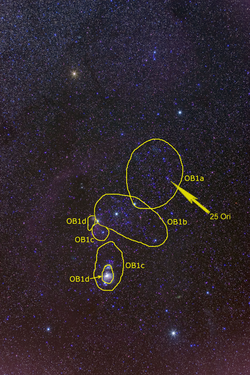Astronomy:Orion OB1
From HandWiki
Short description: Hot giant star group
| Orion OB1 | |
|---|---|
 | |
| Observation data (J2000 epoch) | |
| Constellation | Orion |
| Right ascension | 05h 36m[1] |
| Declination | −01° 12′[1] |
| Mean distance | 1040-1630 ly (320-500 pc[1]) |
| Physical characteristics | |
| Mass | >8.0×103[2] M☉ |
Orion OB1 (Ori OB1) is a contingent group of several dozen hot giant stars of spectral types O and B in Orion. Associated are thousands of lower-mass stars, and a (smaller but significant) number of protostars. It is part of the larger Orion molecular cloud complex. Owing to its relative closeness and complexity it is the most closely studied OB association.[1]
The Orion OB1 consists of the following subgroups:[1][3]
- Orion OB1a - the group of stars northwest of the Orion Belt stars with an average age of about 12 million years. Within this grouping is another subgroup known as the 25 Orionis group.[4][5] They are located near the star of Bellatrix.
- Orion OB1b - the three bright stars ζ Ori (Alnitak), ε Ori (Alnilam), and δ Ori (Mintaka) which make up the asterism known as "Orion's Belt", and minor stars. This group has an average age of approximately 8 million years and is further subdivided into three subgroups.[6][7]
- Orion OB1c - the stars in Orion's Sword that are created by 42 Orionis, θ Orionis, and ι Orionis. These stars are about 3-6 million years old.
- Orion OB1d - the stars of the Orion Nebula and M43 (the youngest stars)
Signatures of stellar debris disk evolution have been detected in the 1a and 1b subgroups.[8][9]
References
- ↑ 1.0 1.1 1.2 1.3 1.4 Brown, A. G. A.; de Geus, E. J.; de Zeeuw, P. T. (September 1994). "The Orion OB1 association. 1: Stellar content". Astronomy and Astrophysics 289 (1): 101–120. ISSN 0004-6361. Bibcode: 1994A&A...289..101B.
- ↑ Cite error: Invalid
<ref>tag; no text was provided for refs namedCIDA - ↑ Blaauw, Adriaan (1964). "The O Associations in the Solar Neighborhood". Annual Review of Astronomy and Astrophysics 2 (1): 213–246. doi:10.1146/annurev.aa.02.090164.001241. Bibcode: 1964ARA&A...2..213B.
- ↑ Briceño, César et al. (June 2007). "25 Orionis: A Kinematically Distinct 10 Myr Old Group in Orion OB1a". The Astronomical Journal 661 (2): 1119–1128. doi:10.1086/513087. Bibcode: 2007ApJ...661.1119B.
- ↑ Harper, Graham M.; Brown, Alexander; Guinan, Edward F. (April 2008). "A New VLA-Hipparcos Distance to Betelgeuse and its Implications". The Astronomical Journal 135 (4): 1430–40. doi:10.1088/0004-6256/135/4/1430. Bibcode: 2008AJ....135.1430H.
- ↑ Warren, W. H., Jr.; Hesser, J. E. (June 1977). "A photometric study of the Orion OB 1 association. I - Observational data". Astrophysical Journal Supplement Series 34: 115–206. doi:10.1086/190446. Bibcode: 1977ApJS...34..115W.
- ↑ Warren, W. H., Jr.; Hesser, J. E. (April 1978). "A photometric study of the Orion OB 1 association. III - Subgroup analyses". Astrophysical Journal Supplement Series 36: 497–572. doi:10.1086/190510. Bibcode: 1978ApJS...36..497W.
- ↑ N. Calvet et al., The Astronomical Journal 129:935–946 (2005)
- ↑ J. Hernandez et al., Astrophys. J. 652:472-481 (2006)
 |

